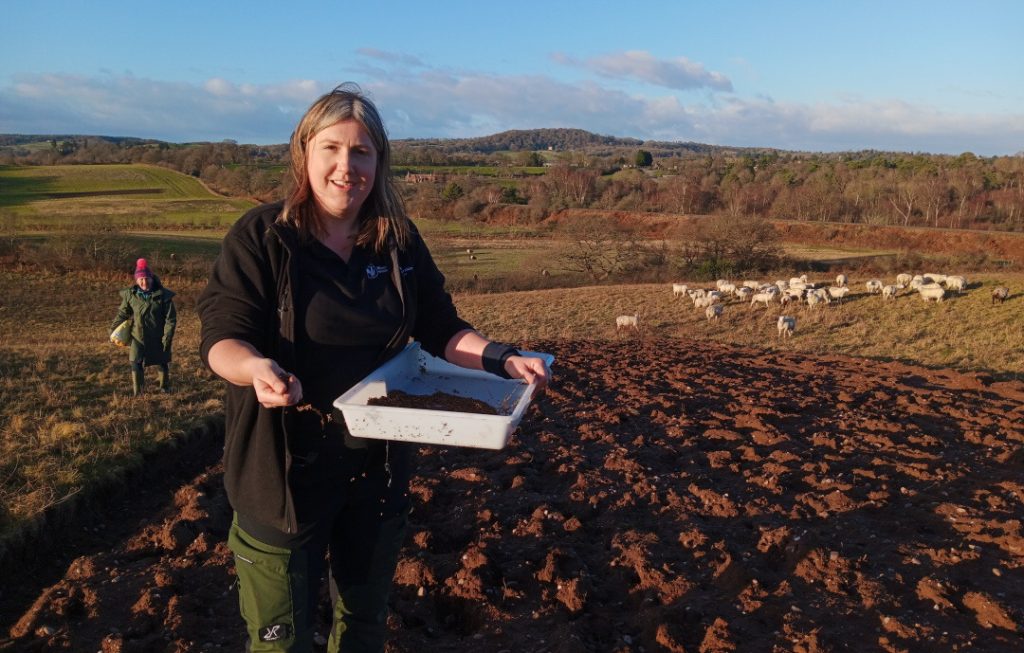STAFF and volunteers from a local charity are uncovering the hidden history of one of the area’s most beloved landmarks.
The Devil’s Spittleful rock sits in the triangle between Kidderminster, Bewdley and Stourport and the project to restore heathland on adjoining land is involving a search into the past to help plan for the future.
In 2021 Worcestershire Wildlife Trust, thanks to funding from the National Lottery Heritage Fund, Severn Waste Services and generous donations, purchased land that connected 600 acres of heathland and acid grassland habitats already by them and Wyre Forest District Council.
The funding enables the charity to undertake restoration of the heathland, work with local communities and to bring in expert help.
Some of that help has involved Worcestershire Archive and Archaeology Service training volunteers to search for artefacts and to help identify what they find.
This then builds on years of historical research undertaken by another team of volunteers. The landscape around the Devil’s Spittle rock today has been manipulated by humans for thousands of years.
Nature reserves are now refuges, stepping stones and reservoirs for wildlife in an intensively managed landscape.
Knowing the history of a site helps organisations like Worcestershire Wildlife Trust understand their current character, geology, hydrology, landscape, vegetation and impact of people.
Insights can be gained as to why wildlife is absent or present while history can help form a cultural connection to a place.
Old maps can be useful too.
An 1883 Ordnance Survey map, for example, shows pools on what today is very dry heathland, yet Victorian publications list the presence of plants like sundew, which only grow in wet, peaty conditions.
Early natural historians emphasise that the ground was marshy and home to ‘waterfowl’.
Any modern visitor will know the site now is very dry and research is ongoing into just how this happened.
The team has found documentation about extraction of water for industry and drinking to supply the fast growing towns of Stourport and Bewdley.
In addition the installation of locks on the nearby River Severn would have destroyed the natural tidal system even this far from the sea.
The construction of what is now the Severn Valley Railway, the military encampment on Burlish Top and ongoing development would have almost certainly affected the water flow.
And whilst this cannot be truly reversed, learning more about the history may help to stop further damage.
At the old military encampment, the team at Worcestershire Archive and Archaeology Service have helped with the locations of World War Two tank tracks and trenches.
In fact, the site has a long history as a training ground for soldiers.
On May 21, 1910, for instance, it was reported in the Dudley Chronicle that the 500-strong 7th Territorial Battalion the Worcestershire Regiment marched onto site.
Among the many artefacts found by volunteers walking the fields, bullets have been one of the most numerous.
Land enclosures, population growth and industrialisation led to the loss of an estimated 90 per cent of heathland in Worcestershire.
On fields at Dropping Well Farm, land that was bought by the Trust in 2021 and now undergoing restoration, volunteers have found bits of storage container pots from the 18th Century, axes and early farm machinery.
Oxen and shire horse shoes give an indication of the move from oxen to horse power in the 1850s while the finding of a gorse hook suggests people were utilising plants that grow naturally in the area – gorse was even encouraged to grow amongst crops as it fed the soil with nitrogen and provided food for horses once the cereals were harvested.
It’s not just relatively modern artefacts that have been found either.
One of the highlights has been a knapped flint knife that’s about 5,000 years old, illustrating just how important this landscape has been.
Today, these wonderful habitats for wildlife provide a window onto a past landscape that once stretched across vast tracts of Worcestershire.
Visitors might not see wildlife like wolves or great bustards making a return to Worcestershire, but if large tracts of undisturbed heath can be restored, they might be lucky enough to see meadow pipits, woodlarks and nightjars return to breed once more.













